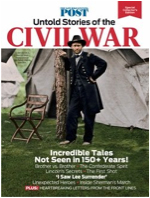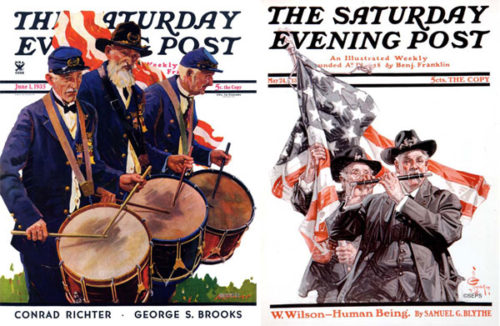Let’s End the Civil War

This article and other stories of the Civil War can be found in the Post’s Special Collector’s Edition, The Saturday Evening Post: Untold Stories of the Civil War.
—This account appeared in the August 11, 1962, issue of The Saturday Evening Post.
There were more Confederate flags sold during the first year of the Civil War Centennial (1961) than were sold throughout the South during the war itself (1861-1865). One hesitates to estimate the number of Confederate flags that will be sold during the next three years, but the prospects are that the total will be more than all the flags sold in all the wars the nation has fought.
Yet the Civil War Centennial is hardly a promotion dreamed up by flag manufacturers. Nor is the centennial merely a project of the enthusiastic city booster to lure the tourist dollar to his hometown. No city booster anywhere in the south or in the north has any intention of proposing a celebration of other conflicts like World War I or World War II or the Korean War.
We celebrate no other war because essentially we believe those wars are over, their outcomes final, the course of history decided. But there are centennial committees throughout the south which would have us think the Civil War is not completely done with, that it ought to be refought. These fellows grow beards, wave flags, and charge over the few meadows the housing developers have left — hoping somehow by this exertion to sustain the illusion that the South may yet snatch victory from defeat. They do everything to re-create the Old South except save Confederate money.
The war started again in July 1961 with the grand reenactment of the Battle of First Manassas (Bull Run), which the South, not surprisingly, won again. Twenty-three states on both sides sent participants, although a large number of soldiers came from the ranks of the North-South Skirmish Association, an organization founded in 1950 by devotees of the muzzle-loading rifle, whose purpose is to hold shooting contests from time to time. For the First Manassas reenactments the participants wore authentic uniforms and carried old muskets whose blank cartridges often bruised the shoulder, blacked the face, and seared the eyes of the unwary.
The son of a friend of mine, a “corporal” in the Guilford Greys (Greensboro, North Carolina), has been “killed” three times since First Manassas and is perfectly willing to give his life in a fourth reenacted battle. It is nice , indeed, to have more than one life to give to one’s country, although the plane fare to the different battlefields is considerable.
The centennial engenders nothing if not sacrifice. The late Bill Polk, editor of the Greensboro Daily News, once showed me a letter from a North Carolina high-school boy which read, in part: “I wish I had been born before the Civil War and had died at Gettysburg.” These mock recruits, I suspect, secretly hope one day the batteries will load real projectiles in the cannons, and the bayonets will be cold steel, not rubber. And this time they will take Washington, D.C.
On To Washington! On To Yesterday!
Certain centennialists seem to believe that once they take the capital, they can force upon the Supreme Court the decisions that will restore the old plantations, the crinolines, the dueling pistols, the house on the hill with smoke coming out the chimney at twilight, and little Sambo rolling in laughter under the magnolia. Ah, what a glorious dream!
Yet it is not entirely an idle dream. The Civil War centennialists have some vague idea that, if they can mount a sufficient show of force, they may not have to deal with the more aggravating and immediate problems of Southern life — the problems that press upon an urban, industrial area that is leaving behind the old, easy agrarian values.

Thus the centennial has turned into a party rather than a pageant. I have even seen a few automobiles decorated with the Stars and Bars, filled with black students, each of the occupants therein wearing the butternut-gray dinks of Confederate soldiers. No centennial committeeman, no matter how skillfully he ties his bowstring, is completely unaware of what is going on in the business district of his hometown. He doesn’t even have to work behind a store counter to know that, in the states of the old Confederacy, at least one-third of all the purchasing power and one-half of all the credit buying comes from the pockets of grandchildren and great-grandchildren of the black slaves.
That realization is why the centennial is something less than a huge success in the big Southern cities. The plan for my own home, Charlotte, North Carolina, by far the largest city of the two Carolinas, was to commemorate the fact that it was the site of the Confederate Navy Yard. It seems that, after the war broke out, the naval stores at Portsmouth, Virginia, were seized and transported inland to Charlotte. The long boardwalk is still called “the wharf.” But except for the members of the committee itself, few people are even aware of the centennial, let alone a Confederate Navy Yard.
Was the “Old South” A Myth?
The chamber-of-commerce fellows are selling the ideals of the modern industrial world because the ideals of the Old South were only make-believe currency. There were Southerners before 1800, but there was no “Old South.” One of our Southern writers, Wilbur J. Cash, in his book The Mind of the South, recalled that boys who cleared out the Indians in the Carolina backwoods lived to command brigades at Bull Run, which means that the Old South could not have been more than two generations old.
The fact is that the Old South was nothing more than a myth and a poem and, as Jimmy Street, another Southern writer, put it, a malady for which there fortunately is a vaccine — the industrial payroll.
The Civil War started with the Negro in slave cabins. But all of the blanks and muskets and beards will not disguise the truth that Negroes serve today on the Republican and Democratic national committees. The real Confederates found cover behind occasional tar-paper shacks. In their place today, the re-created regiments and brigades have to charge around factories where the skilled workmen inside knock off a few minutes to cheer them on.
The time has come to end the Civil War because we are one country with one economy. We cannot take time out from industrial and urban problems of unemployment, housing, schooling, and civil rights to indulge ourselves in silly excess, celebrating a time that no longer is — and never was. The truth is that, at best, the centennial provides but a minor amusement.
“Lets End the Civil War,” August 11, 1962